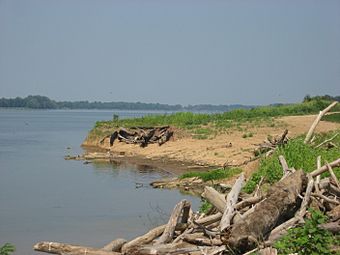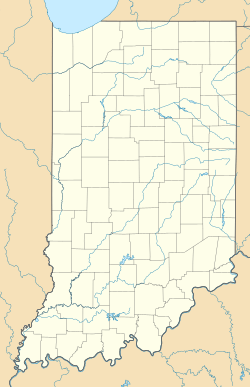Yankeetown site facts for kids
Quick facts for kids |
|
|
Yankeetown archeological site
|
|

Eastern portion of the site
|
|
| Location | Along the Ohio River bank in Section 21 of Anderson Township, south of Yankeetown, Indiana |
|---|---|
| Area | 140 acres (57 ha) |
| NRHP reference No. | 79000026 |
| Added to NRHP | February 28, 1979 |
The Yankeetown site (also known as 12W1) is an important archaeological site located by the Ohio River in southwestern Indiana. People lived here a very long time ago, during a time called the Woodland period. This site has taught us a lot about these ancient people. Even though the river has caused some damage, it has been a protected historic site for over thirty years.
Contents
Where is the Yankeetown Site?
The Yankeetown site is mostly in Warrick County, near a small community called Yankeetown. It sits right along the bank of the Ohio River. The site stretches for about 0.75 miles (1.2 km) along the riverbank.
Unfortunately, the river has caused a lot of erosion here. In 1950, people living nearby said that about 20 feet (6 meters) of the riverbank was washed away every year. This erosion has made it harder to study the site.
Exploring the Past: Excavations
In April 1950, a famous archaeologist named Glenn Albert Black visited the Yankeetown site. He and his team carefully looked for clues about the people who once lived there. Because of the river's erosion, they could easily see things like old pits and hearths (ancient fireplaces).
They found many artifacts, which are objects made by people long ago. These included small clay pieces, bits of charcoal, and burned clay. A few months later, another team explored the site. They found a layer of daub (a mix of mud, clay, and straw used for building) about 8 inches (20 cm) deep. This layer was important because it had burned debris and grass, suggesting it might have been where an ancient house stood.
Amazing Artifacts Found
Many of the artifacts from Yankeetown are kept safe at the museum at Angel Mounds State Memorial in Evansville. Thousands of sherds (broken pieces of pottery) have been found at Yankeetown. Most of these pottery pieces were strengthened with clay or grit. Some even had tiny pieces of shell mixed in.
A lot of the pottery was plain, but hundreds of pieces had cool designs. These designs were made by pressing cords into the wet clay or by carving lines into it. Other rare items found include flint knives, hammerstones (stones used for pounding), and tools called trowels. They also found animal bones and objects made from a shiny black rock called cannel coal. Two damaged pottery figures of women were also discovered, though they were broken below the shoulders.
What We Learned from Yankeetown
The archaeologists who studied Yankeetown in 1950 named a special type of pottery after the site. This pottery had unique decorations made by adding clay strips (called "appliqué") or by carving designs (called "incision"). When this type of pottery was found elsewhere, it was called "Yankeetown fillet" or "Yankeetown incised."
Similar objects to those found at Yankeetown have been discovered in other places, even far away. They have been found north of Vincennes, Indiana, at the Great Salt Spring in Illinois, and near St. Louis, Missouri. This suggests that the people who made these items traveled or traded with others over a wide area. The Yankeetown culture seems connected to another ancient culture called the Duffy complex.
Protecting the Yankeetown Site
Protecting the Yankeetown site has been a challenge because of the river's constant erosion. However, keeping the artifacts at the Angel Mounds museum helps save important information about the site. To help protect it even more, the Yankeetown site was added to the National Register of Historic Places in 1979. This means it is recognized as an important historical location.
It is one of eight places in Warrick County listed on the National Register. Other protected sites in the county include parts of the Angel Mounds State Memorial and the nearby Caborn-Welborn Mississippian site, known as the Ellerbusch site.



